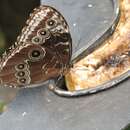en
names in breadcrumbs


Morpho peleides is easily recognized by the iridescent blue wings. It is possible to differentiate between other Morpho species and M. peleides due to its dark brown and pupillate eye spots on the underside (Young, A.M. & Muyshondt 1973). It is found from Mexico to Columbia on both the Atlantic and the Pacific side of the continental divide (DeVries 1987), from sea level to 1800 m and can also be found in Trinidad (Urich & Emmel 1991). While M. peleides is sometimes considered a subspecies of Morpho helenor (Constantino & Corredor 2004), mainly there is considered to be two forms of M. peleides, one that is entirely iridescent blue on the top while the other has the blue highly reduced (Young, A.M. & Muyshondt 1973). Eggs of M. peleides are dome shaped and laid singly on the underside of host plant leaves. Host plants could be Mucuna spp. (Fabaceae), Machaeriumspp. (Fabaceae), and Pterocarpus spp. (Fabaceae). Larvae can reach up to 9 cm and are red and yellow. The development to go from an egg to an adult is around 115 days (Young & Muyshondt 1973).Adults are most often found flying along rivers, road ways or any area where some sort of open path has been cut. Their flight has been described as “floppy” and “zigzag” however they are very adept at getting away from predators when necessary (DeVries 1987). Adults feed mostly on rotting fruit but have been seen feeding on mud and carrion as well (Young 1975). Males are most active between early morning until midday while females are most active right around midday.
Morpho peleides, the Peleides blue morpho, common morpho[1] or the emperor[2][3] is an iridescent tropical butterfly found in Mexico, Central America, northern South America, Paraguay and Trinidad. Most authorities[4] believe that peleides is a subspecies of Morpho helenor.[5]
The brilliant blue color in the butterfly's wings is caused by the diffraction of the light from millions of tiny scales on its wings. It uses this to frighten away predators, by flashing its wings rapidly. The wingspan of the blue morpho butterfly ranges from 7.5–20 cm (3.0–7.9 in). The entire blue morpho butterfly life cycle, from egg to adult is only 115 days. This butterfly undergoes metamorphosis from larva to butterfly. The larva eats plant leaves before spinning a chrysalis. Flower nectar, which is available later in the year, is used by the butterfly. A recent study also discovered that during transformation, the butterfly substantially reduces its body weight and body fat.[6] Known larval food plants are Leguminosae (Arachis hypogaea, Dioclea wilsonii, Inga species, Lonchocarpus, Machaerium cobanense, Machaerium salvadorense, Machaerium seemannii, Medicago sativa, Mucuna mutisiana, Pithecellobium, Pterocarpus rohrii, Mucuna urens) and Bignoniaceae (Paragonia pyramidata). Morpho peleides drinks the juices from rotting fruits for food. Its favorites in captivity are mango, kiwi, and lychee. Morpho peleides butterflies live in the rainforests of South America, and can be found in Mexico and Central America.
The larvae of Morpho peleides butterflies are occasional cannibals. These caterpillars are red brown with patches of bright green.
Morpho peleides, the Peleides blue morpho, common morpho or the emperor is an iridescent tropical butterfly found in Mexico, Central America, northern South America, Paraguay and Trinidad. Most authorities believe that peleides is a subspecies of Morpho helenor.
The brilliant blue color in the butterfly's wings is caused by the diffraction of the light from millions of tiny scales on its wings. It uses this to frighten away predators, by flashing its wings rapidly. The wingspan of the blue morpho butterfly ranges from 7.5–20 cm (3.0–7.9 in). The entire blue morpho butterfly life cycle, from egg to adult is only 115 days. This butterfly undergoes metamorphosis from larva to butterfly. The larva eats plant leaves before spinning a chrysalis. Flower nectar, which is available later in the year, is used by the butterfly. A recent study also discovered that during transformation, the butterfly substantially reduces its body weight and body fat. Known larval food plants are Leguminosae (Arachis hypogaea, Dioclea wilsonii, Inga species, Lonchocarpus, Machaerium cobanense, Machaerium salvadorense, Machaerium seemannii, Medicago sativa, Mucuna mutisiana, Pithecellobium, Pterocarpus rohrii, Mucuna urens) and Bignoniaceae (Paragonia pyramidata). Morpho peleides drinks the juices from rotting fruits for food. Its favorites in captivity are mango, kiwi, and lychee. Morpho peleides butterflies live in the rainforests of South America, and can be found in Mexico and Central America.
The larvae of Morpho peleides butterflies are occasional cannibals. These caterpillars are red brown with patches of bright green.